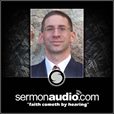Weekly Sermon
James 1:14-15 reads, “But every man is tempted, when he is drawn away of his own lust, and enticed. Then when lust hath conceived, it bringeth forth sin: and sin, when it is finished, bringeth forth death.”
As we have previously noted, James 1:12-18 gives counsel concerning a right motivation for endurance in godliness, concerning a right attitude toward the Lord our God, and concerning a right understanding of temptation unto sin. Overall, this subject matter is arranged in order to move our focus and understanding from the outside toward the center. Thus verse 12 & verses 17-18 give counsel concerning our right motivation for endurance in godliness. Then verse 13 & verses 16-17 give counsel concerning our right attitude toward the Lord our God. Finally, verses 14-15 give counsel concerning our right understanding of temptation to sin.
Verse 14 begins with the adversative conjunction “but,” providing a direct contrast to the truth of verse 13. The closing portion of verse 13 proclaims the truth, “For God cannot be tempted with evil, neither tempteth he any man.” Indeed, our all-holy Lord God is never the cause of our sinful temptation, either directly or even distantly through our personal constitution, relational contacts, or individual circumstances. So then, who or what is the cause of our sinful temptation? In contrast to the truth of verse 13, verse 14 gives answer, saying, “But every man is tempted, when he is drawn away of his own lust, and enticed.”
Grammatically, James 1:14-15 presents three statements that reveal a three-step process whereby sinful temptation and sinful behavior take hold upon our hearts and lives. Each of these three statements contains the relative conjunction “when,” revealing a conditional truth that when a certain event occurs, then a certain result will arise. First, verse 14 presents the character of sinful temptation -- “But every man is tempted, when he is drawn away of his own lust, and enticed.” Second, the opening portion of verse 15 presents the conception of selfish desire -- “Then when lust hath conceived, it bringeth forth sin.” Third, the closing portion of verse 15 presents the consequence of sinful behavior -- “And sin, when it is finished, bringeth forth death.”
Through these three statements, we may observe seven progressive elements in the realm of sinful temptation and sinful behavior. However, before we focus our attention upon these seven elements, we should consider three introductory and foundational truths to this subject matter. The first foundational truth is that sinful temptation is a universal matter. The opening line of James 1:14 states, “But every man is tempted.” In like manner, the opening portion of 1 Corinthians 10:13 states, “There hath no temptation taken you but such as is common to man.” Each and every one of us is tempted unto sin, and is tempted on a regular basis. Sinful temptation is a characteristic element of our lives upon this earth. The second foundational truth is that sinful fault is a personal matter. James 1:14 continues, “But every man is tempted, when he is drawn away of his own lust, and enticed.” Each and every one of us is tempted of our own, personal lust (that is -- of our own, selfish desire). Therefore, each and every commission of sin, whether in attitude, word, action, or neglect, is our own, personal fault and responsibility. The third foundational truth is that sinful behavior is a consequential matter. James 1:15 declares, “Then when lust hath conceived, it bringeth forth sin: and sin, when it is finished, bringeth forth death.” Yielding to sinful desire always results in destructive consequences. Whenever we consent in our heart to be drawn away from our Lord’s fellowship and to be enticed by sin’s deceptive pleasures, sin will be the consequence in some form. Furthermore, whenever we commit sin in some form, death will be the consequence in some manner.
So then, having considered these three foundational truths to this matter, we now come to the seven progressive elements in the realm of sinful temptation and sinful behavior.
James 1:14-15 reads, “But every man is tempted, when he is drawn away of his own lust, and enticed. Then when lust hath conceived, it bringeth forth sin: and sin, when it is finished, bringeth forth death.”
As we have previously noted, James 1:12-18 gives counsel concerning a right motivation for endurance in godliness, concerning a right attitude toward the Lord our God, and concerning a right understanding of temptation unto sin. Overall, this subject matter is arranged in order to move our focus and understanding from the outside toward the center. Thus verse 12 & verses 17-18 give counsel concerning our right motivation for endurance in godliness. Then verse 13 & verses 16-17 give counsel concerning our right attitude toward the Lord our God. Finally, verses 14-15 give counsel concerning our right understanding of temptation to sin.
Verse 14 begins with the adversative conjunction “but,” providing a direct contrast to the truth of verse 13. The closing portion of verse 13 proclaims the truth, “For God cannot be tempted with evil, neither tempteth he any man.” Indeed, our all-holy Lord God is never the cause of our sinful temptation, either directly or even distantly through our personal constitution, relational contacts, or individual circumstances. So then, who or what is the cause of our sinful temptation? In contrast to the truth of verse 13, verse 14 gives answer, saying, “But every man is tempted, when he is drawn away of his own lust, and enticed.”
Grammatically, James 1:14-15 presents three statements that reveal a three-step process whereby sinful temptation and sinful behavior take hold upon our hearts and lives. Each of these three statements contains the relative conjunction “when,” revealing a conditional truth that when a certain event occurs, then a certain result will arise. First, verse 14 presents the character of sinful temptation -- “But every man is tempted, when he is drawn away of his own lust, and enticed.” Second, the opening portion of verse 15 presents the conception of selfish desire -- “Then when lust hath conceived, it bringeth forth sin.” Third, the closing portion of verse 15 presents the consequence of sinful behavior -- “And sin, when it is finished, bringeth forth death.”
Through these three statements, we may observe seven progressive elements in the realm of sinful temptation and sinful behavior. However, before we focus our attention upon these seven elements, we should consider three introductory and foundational truths to this subject matter. The first foundational truth is that sinful temptation is a universal matter. The opening line of James 1:14 states, “But every man is tempted.” In like manner, the opening portion of 1 Corinthians 10:13 states, “There hath no temptation taken you but such as is common to man.” Each and every one of us is tempted unto sin, and is tempted on a regular basis. Sinful temptation is a characteristic element of our lives upon this earth. The second foundational truth is that sinful fault is a personal matter. James 1:14 continues, “But every man is tempted, when he is drawn away of his own lust, and enticed.” Each and every one of us is tempted of our own, personal lust (that is -- of our own, selfish desire). Therefore, each and every commission of sin, whether in attitude, word, action, or neglect, is our own, personal fault and responsibility. The third foundational truth is that sinful behavior is a consequential matter. James 1:15 declares, “Then when lust hath conceived, it bringeth forth sin: and sin, when it is finished, bringeth forth death.” Yielding to sinful desire always results in destructive consequences. Whenever we consent in our heart to be drawn away from our Lord’s fellowship and to be enticed by sin’s deceptive pleasures, sin will be the consequence in some form. Furthermore, whenever we commit sin in some form, death will be the consequence in some manner.
So then, having considered these three foundational truths to this matter, we now come to the seven progressive elements in the realm of sinful temptation and sinful behavior.



 RSS Feed
RSS Feed
